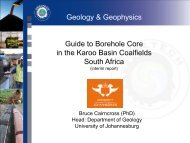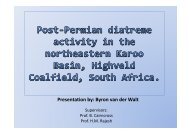coaltech upper olifants river catchment wetland inventory ...
coaltech upper olifants river catchment wetland inventory ...
coaltech upper olifants river catchment wetland inventory ...
You also want an ePaper? Increase the reach of your titles
YUMPU automatically turns print PDFs into web optimized ePapers that Google loves.
3.3.6 Fish<br />
The UORC has a low diversity of fish species (Palmer et al 2002). Historically the <strong>catchment</strong><br />
had 11 indigenous fish species, but this has lowered to eight at present. In addition three<br />
exotic and three translocated indigenous species occur in the <strong>catchment</strong>. The presence of<br />
large impoundments is probably the most important factor limiting the distribution of the fish<br />
species, limiting the movement of the species and lowering the potential habitat for several<br />
indigenous fish species (Heath and Claassen 1999, Palmer et al 2002).<br />
3.3.7 Vegetation<br />
According to Palmer et al (2002) the <strong>wetland</strong>s in the UORC has high plant species diversity.<br />
In their study they recorded 354 indigenous and 59 exotic plant species. There seems to be<br />
considerable local and regional diversity in the plant species composition, and richness<br />
between and within the different <strong>wetland</strong> types in the <strong>catchment</strong>. The variability can be<br />
attributed to a variety of factors including hydrological characteristics and water quality, but<br />
more detailed studies should be conducted in order to reach any conclusion on the impact of<br />
various <strong>wetland</strong> characteristics on the <strong>wetland</strong> vegetation (Palmer et al 2002).<br />
Hillslope seepage <strong>wetland</strong>s in the <strong>catchment</strong> are the most impacted systems in the UORC,<br />
due to agricultural practices such as cultivation of crops and pastures. The species diversity<br />
in this <strong>wetland</strong> type is therefore probably not an accurate indication of the natural situation<br />
(Palmer et al 2002).<br />
Pans are poorly studied systems with little information available on the changes on plant<br />
species diversity in relation to the changes in the water dynamics of the <strong>wetland</strong>s (Palmer et<br />
al 2002).<br />
Red Data plant species have been recorded in the <strong>wetland</strong>s of the UORC. It is possible that<br />
some additional Red Data species that have not been recorded in any of the publications can<br />
utilise the <strong>wetland</strong>s in the <strong>catchment</strong> (Palmer et al 2002). None of the plant species recorded<br />
in the literature are included in one of the IUCN threat categories. One of the species,<br />
Calamagrostis epigeios var. capensis is a Near Threatened species and is therefore a<br />
species of concern. A number of protected species have also been listed.<br />
Wetland Database for UORC - 27 -




